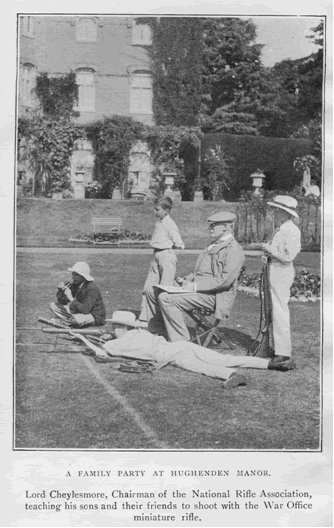
Please be aware that some specialist imagery may take time to load.
This site is designed for dedicated researchers on desktop or tablet, not ideal for mobile browsing.
and, if you have not just arrived here from that page, read a comprehensive write-up on the rifle, or its War Office Specification.

CONTENTS.
.................CHAPTER I........................................... PAGE
Miniature Rifle Shooting ....................................................
1
CHAPTER II.
Various Types of Action ......................................................
8
CHAPTER III.
The War Office Miniature Rifle..........................................
13
CHAPTER IV.
The Flight of the Bullet ........................................................
24
CHAPTER V.
Hints on Shooting
and the General Care of the Rifle ......... 35
TRAJECTORY TABLES.
TABLE I.
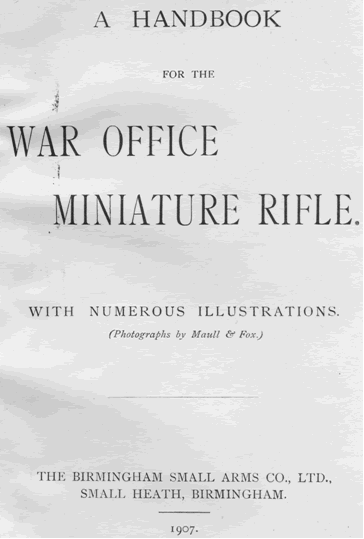 .22
Long-Rifle Rim-Fire Cartridge............................ 31
.22
Long-Rifle Rim-Fire Cartridge............................ 31
TABLE II.
.22 Short Black Rim-Fire Cartridge..........................
32
TABLE III.
.22 Short Smokeless Rim-Fire.....................................
33
_____________
Description of the Mechanism
of the W.O.M. Rifle .. 15
General Statistics of the Rifle........................................
20
A HANDBOOK
FOR THE
WAR OFFICE MINIATURE RIFLE.
____________
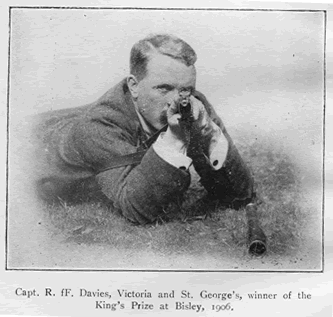
CHAPTER I.
MINIATURE RIFLE SHOOTING.
As rifles become more powerful and as our
cities and towns extend their boundaries the opportunities for rifle shooting
become more and more restricted. The prevailing desire that every British
subject shall be versed in the use of the rifle must accordingly find its
expression in the multiplication of miniature ranges. These may be situated
in a variety of out-of-the-way corners, easily accessible from inhabited
centres. To judge by the results already attained, well organised practice
at such distances as 25, 50, and 100 yards brings into being those qualities
of marksmanship which were found to be so conspicuously lacking in many
otherwise good soldiers taking part in the South African campaign. The process
of creating a new pastime necessarily brought forward a large number of
problems which had never previously been practically considered. The equipment
of suitable ranges, the organisation of clubs, and the framing of rules
to govern rifle shooting contests all received a due amount of attention.
That the results have been satisfactory must be credited, first, to the
interest which has been shown in the new idea by men of wealth and influence,
and, second, to the clubbable and sporting instincts of the English-speaking
race.
To shoot at Bisley is the ultimate aim of most young marksmen, and to graduate
at the miniature ranges is the most certain, and probably the quickest,
way of getting there. So many elements enter into the achievement of skill
in shooting that it is desirable to divide the course of tuition into stages.
To endeavour to master the intricacies of wind judgment, whilst the ability
to take steady aim is still undeveloped, is to introduce an unknown and
variable factor which brings about too many " unaccountables "
for steady progress to be possible. Before a mag. or outer can be for certain
attributed to an unexpected puff of wind the shooter must be able to say
with complete conviction that the error was not of his own making. Miniature
shooting thus has the merit of excluding for the most part all wind disturbance,
so fixing the mind on the very important task of holding the rifle in true
alignment with the target, whilst pressing the trigger.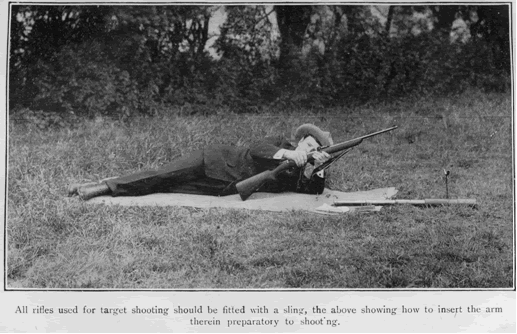
To shoot at full-distance military ranges mostly involves a railway journey
of some miles and the expenditure of more money than most beginners are
able to spare in subscriptions, railway fares, and ammunition charges. The
value of the practice obtained is restricted by the relatively small number
of rounds which can be fired, and by the circumstance that the wind provides
too convenient an excuse for the loss of points which really arise from
faulty manipulation of the rifle. The very limitations of miniature range
shooting provide a means for properly grasping the rudiments of the art
of shooting. A bad habit once developed is most difficult to eradicate ;
and in the case of rifle shooting many of its votaries are for ever debarred
from attaining the highest position, because the earlier stages of their
training were not conducted under conditions providing a prompt tell-tale
proof of the bad habits which existed.
The new War Office miniature rifle represents a praiseworthy effort on the
part of various official and other authorities on musketry instruction to
devise an arm capable of extracting the best results from rifle practice
at miniature distances. By its lighter weight and more advantageously disposed
balance it minimises the difficulties attendant on the steady holding of
a full-size service rifle. Until long practice has made the ordinary prone
firing position easy and comfortable an ordinary military rifle seems cumbersome
and overweighted, a property which is the more apparent to boys and youths
who have not as yet developed the strength and general physical development
which comes with maturity. Cost, again, is a factor which can never be ignored.
Rifle shooting is most likely to excel as a national sport if it can be
developed on self-supporting lines. If heavily subsidised by the Government
some of its vitality might be lost, certainly private enterprise would be
diminished.
The introduction of the W.O. miniature model rifle, by reducing the cost
of rifles and ammunition as used by clubs, should be as valuable in the
long run as an annual grant from the national exchequer, whilst still in
no way trenching on the democratic organisation of our rifle clubs.
The new miniature rifle has been so happily proportioned in regard to weight
and dimensions, that the most skilful shooter of mature years will not disdain
to practise with it, and at the same time it will not feel heavy or cumbersome
in the hands of the average lad of twelve or thirteen years of age. The
system of sights is based on a true military model. The sling attachments
provide reasonable facilities for cultivating the approved Bisley method
of holding, and the bolt action accustoms the shooter to a design of breech
closure which is universal from the military standpoint. Notwithstanding
the considerations of economy which have influenced the general style of
the rifle, the trigger-action has been devised on the latest " double-pull
" motion. The first stage of the releasing movement transfers the mechanism
from the " very safe " position—which it assumes after closing
the bolt—to the " very ready " position, the latter preceding
the final release.
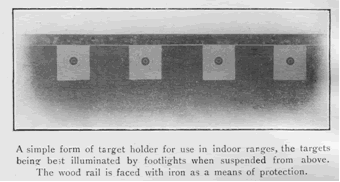

The fact that the new rifle
has been bored and chambered for a brand of cartridge which can be issued
at a profit by the club at a price of 2d. for seven rounds, including the
cost of the target, has abolished a serious difficulty in club administration.
A single shilling will cover the entire cost of a busy afternoon's practice
at the ranges, this sum representing the entry fees for no fewer than six
separate competitions, a very different state of affairs from what exists
when cartridges cost as much as 3s. 6d. for 100 rounds, with no profit to
cover the expenses of club management. Not only is the cost of the rifle
small in itself, but, being an official model, it answers once and for all
the question, What rifle shall I buy ? The postponement of purchasing
one's own rifle, or, in the case of a club, the difficulty of deciding what
arm to adopt for general use, arises very often from the fear that a purchase
once made may form the subject for regret afterwards. The W.O. miniature
rifle, on the other hand, gives every prospect of becoming a permanent asset
to its owner. Its manufacture by such a company as the Birmingham Small
Arms Co., Ltd., ensures not only a high grade of workmanship, but the power
at all times to replace, promptly and at small cost, any part which may
become worn or defective by long use or neglect.
The formation of rifle clubs has thus been deprived of its greatest anxiety.
Four or five rifles for general use, to be supplemented by others privately
owned, will represent the only serious capital charge. The necessary target
apparatus can be installed for a few shillings, and on a well-chosen piece
of ground safety conditions can be sufficiently assured by the erection
of turf mounds such as an ordinary labourer can set up. The firing point
consists merely of a row of cocoanut mats, and, therefore, involves no serious
outlay. In point of fact the secret of success is to cut down initial expenses
to the smallest possible extent, in the knowledge that money is best spent
if devoted to satisfying needs when they actually arise. A few supplies
in the way of targets, cleaning apparatus, and a thousand or so rounds of
ammunition will form the essentials upon which the first day's shooting
may be commenced.
The personnel of the club's organisation should be framed on a similarly
practical basis. The secretary will probably be the moving spirit in the
enterprise. Those who rally round him will form the committee and honorary
element. The club may be started with £10 capital and ten members.
As soon as its existence becomes known, another ten will join in, and a
total of twenty qualifies for affiliation with the National Rifle Association.
A formal letter to Col. C. R. Crosse, at Bisley Camp, Brookwood, Surrey,
will bring by way of reply particulars of the simple qualifying conditions
which are deemed essential. Formalities having been completed, and the modest
fee paid, a welcome surprise greets the secretary of the club when he finds
that there is already something to shoot for, something to stimulate the
enthusiasm and interest of the members, and something to show that the N.R.A.
is really interested in the success of its latest recruit. That is to say,
each club which is affiliated with the National Rifle Association receives
the Donegal Bronze Medal, an appropriate reward for the shooter who makes
the most consistent scoring in the course of the season. Each club also
receives a series of forms relating to the marksmanship certificates which
are awarded to every shooter who has attained a specified standard of marksmanship.
Taking it all round, the formation of a successful rifle club involves little
more effort than the will-power to make the initial plunge. When once the
launch has been successfully accomplished, the rest is merely a question
of plain sailing. With reasonably active secretarial management, a club
can hardly fail to succeed, and this for the reason that we all have within
us the latent desire to become marksmen and an instinctive sympathy for
the rifle and its use.
CHAPTER II.
VARIOUS TYPES OF ACTION.
THE prime justification for the War Office
miniature rifle is its close affinity with the military model. It can, however,
be shown that its main characteristics may be further justified on the principle
of the survival of the fittest. The various stages in the course of the
development which rifles have undergone can best be illustrated by the quotation
of actual examples. The Martini action is doubtless the most familiar to
the average reader. The chamber orifice is closed by means of a hinged block,
pivoted at the rear end, and operated by an under-lever. The essential disadvantage
of this action for miniature rifles generally lies in the circumstance that
the bore is inaccessible from the rear. Such a system of construction introduces
serious inconveniences in regard to cleaning operations. In no class of
rifle is rust more quickly developed by neglect, or more serious in its
results than with arms firing •22 calibre rim-fire ammunition. The
barrel needs attention not only after firing and before putting away, but
during the actual progress of shooting. In hot, dry weather there is always
the possibility that fouling may accumulate in the bore in sufficient quantities
to deteriorate the quality of the shooting obtained. 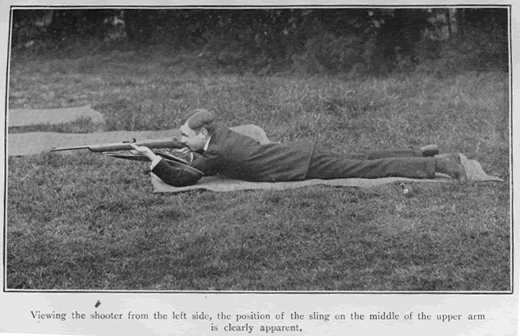 The
power at all times to wipe out the inside of the barrel without delay and
inconvenience is, therefore, a first essential in a miniature rifle. To
be able to satisfy oneself that the bore is clean around the chamber is
a necessary feature of the cleaning process. The Martini action can be fitted
with a removable barrel, so overcoming this primary disability at the cost
of a certain amount of extra trouble.
The
power at all times to wipe out the inside of the barrel without delay and
inconvenience is, therefore, a first essential in a miniature rifle. To
be able to satisfy oneself that the bore is clean around the chamber is
a necessary feature of the cleaning process. The Martini action can be fitted
with a removable barrel, so overcoming this primary disability at the cost
of a certain amount of extra trouble.
Another disadvantage of the Martini action is that it does not lend itself
to the fitting of a satisfactory ejecting mechanism for .22 calibre rim-fire
cartridges. This fault is general in all rifles falling within a certain
group of construction. In other words, the shot gun system of extraction
and ejection is not applicable to all kinds of cartridge cases. For the
purposes of description the processes incidental to removing the empty cartridge
shell may be divided into primary extraction and final ejection. Cartridge
chambers are mostly made with a slight taper, which leaves the back larger
in diameter than the front The leverage exerted on the extracting piece
forcibly withdraws the empty shell until it lies in a larger part of the
chamber. Supposing the taper to be sufficient to free the case from any
grip it may have had on the walls of the chamber, a slight extra flip should
throw it out clear of the gun or rifle. That things do not always work out
as intended must be apparent to most users of miniature rifles. The failure
to provide for the satisfactory ejection of •22 calibre empty shells
must be attributed to the circumstance that the grip of the chamber never
really ceases
until the case has been completely withdrawn. The inability of the ejecting
flip to expel an ordinary •22 cartridge case is also influenced by
the circumstance that it does not possess sufficient weight or substance
to continue by its own momentum the motion first imparted to it. The long
bolt travel of the W.O. miniature rifle provides for the complete removal
from the chamber of the empty cartridge case before even an attempt is made
to give it the flip which throws it clear of the rifle.
There are various other rifle mechanisms which are more or less analogous
to the Martini, but which leave a clear view of the rear end of the barrel
when the action is open. Such rifles are mostly of the falling block type,
and much ingenuity has been expended in combining in a convenient form the
various essential parts such as the trigger, hammer, extractor, cocking
mechanism when such exists, and so forth.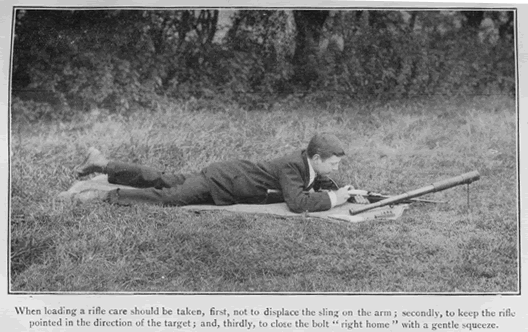
Public opinion now favours a design of rifle which will approximate more
closely to the military conditions which have formed the dominating idea
in the inception of the true cadet rifle. Even if allegiance to the bolt
is considered of secondary importance, there remain various other objections
to existing well-known types of rifles which are as yet unmet. The designing
of small rifles is necessarily restricted by the market conditions they
must encounter. The shooter seldom judges his rifle by the open sights supplied
with it, and as few things add so much to the cost of a rifle as a satisfactory
set of open sights, economy is studied in this quarter by the manufacturer.
The shooter does not mind, because he knows that for the use he contemplates
making of his rifle a peephole backsight fitted on the hand-grip will supply
a most excellent means of accurate alignment. As the bolt action does not
lend itself to the use of a peephole fixed on the grip of the stock, this
class of sight is regarded as unmilitary. A natural prejudice accordingly
exists against practising at miniature ranges with appliances out of character
with Bisley conditions. In the W. 0. Miniature rifle a large proportion
of the total cost of manufacture has been allocated to the provision of
a military style of sights, having a refinement of adjustment and a solidity
of construction which will help to remove the yearnings for a peephole.
Another class of rifle which has achieved great success in consequence of
the lack of an arm exactly suited to the needs of the miniature range shooter
is the small toy-like bolt rifle. Considerable differences exist between
one type and another as regards workmanship, accuracy of shooting, and general
efficiency under practical conditions of use. The only objection which can
be lodged against these rifles as a class is that they aim at too low a
cost; but, being of too " miniature " a character, they hardly
merit serious consideration when club rifles are in question. The new W.O.
rifle strikes a happy mean between starvation of cost on the one hand, and
expensive elaboration on the other. The W. 0. miniature rifle is fitted
with a simple and inexpensive bolt action ; it possesses a man's size of
stock ; it is of sufficient length to carry practical military sights; it
has swivels for the attachment of a sling ; in fact, it represents a special
rifle designed for a special purpose, and better carries out that purpose
than other rifles made with other ends in view.
A few words about magazine actions will suffice to bring this chapter to
a close. In the early days of miniature rifle club shooting magazine arms
were recommended to the exclusion of all other types. They accordingly enjoyed
a certain vogue, but for practical club shooting they were proved to possess
disadvantages outweighing the possible benefits.
It would be wrong to express too general a condemnation of the magazine
system as applied to •22 rifles. Some, in fact, work very well indeed
; but the subject may be dismissed for the time being pending the production
of a more suitable cartridge than at present exists. One thing is, however,
certain, viz., that no arm is by its general design better adapted for a
magazine than the W.O. miniature rifle, and when the time is ripe this extra
refinement will doubtless be added.
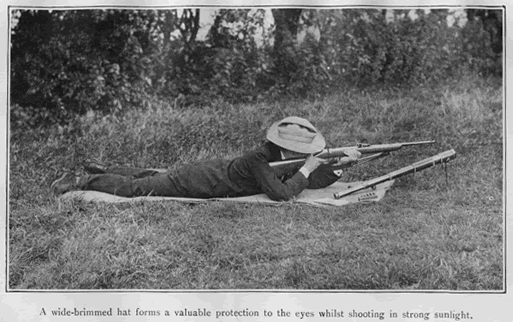
CHAPTER III.
THE WAR OFFICE MINIATURE RIFLE.
SINCE miniature rifle shooting has become
a recognised section of target practice the need for an official type of
arm has been apparent to experts and marksmen alike. That need the new rifle
satisfies. Further improvements may be made as years go on ; but they will
be modifications of the present design, and can hardly take the form of
radical re-construction. The lines of the rifle have been laid down on correct
principles, and a debt of gratitude is due to the statesmanlike efforts
of the Committee which took so difficult a task in hand. Within less than
a year of the initiation of their labours, finished, machine-made rifles
will be in general use by the public—a fine achievement whose credit
is shared by the Committee, which laid down general rules and principles
; the manufacturers, who submitted a variety of models complying with the
skeleton specification which was issued ; the War Office, which harmonised
differences and produced one model out of many ; and, finally, the manufacturing
element, which has made arrangements for the infinite duplication of the
approved model.
The details of the model of rifle adopted are fully shown in the various
illustrations which accompany this volume. To deal first of all with the
weight and balance of the new rifle, no words or figures could express the
same more perfectly than the graphical representation which appears on the
adjoining page.  Two
spring balances are placed at a distance of 12 ins. apart. They support
the rifle at the approximate positions the hands occupy, and the dials show
the weight which each hand sustains. The service rifle and the W. O. miniature
rifle have been similarly treated, and the dials give a clear representation
of the total weight of each rifle, and its distribution between the two
hands. The miniature rifle clearly gives conditions which tend to minimise
fatigue in holding during the early stage of practice. It is time enough
for the young shooter when he has learnt to control his breathing and combine
even trigger pressure with true alignment to add to his difficulties by
asking him to do likewise with a •22 Lee-Enfield.
The more thoroughly the first course is mastered, the more rapid will be
the subsequent progress when serious problems are tackled.
Two
spring balances are placed at a distance of 12 ins. apart. They support
the rifle at the approximate positions the hands occupy, and the dials show
the weight which each hand sustains. The service rifle and the W. O. miniature
rifle have been similarly treated, and the dials give a clear representation
of the total weight of each rifle, and its distribution between the two
hands. The miniature rifle clearly gives conditions which tend to minimise
fatigue in holding during the early stage of practice. It is time enough
for the young shooter when he has learnt to control his breathing and combine
even trigger pressure with true alignment to add to his difficulties by
asking him to do likewise with a •22 Lee-Enfield.
The more thoroughly the first course is mastered, the more rapid will be
the subsequent progress when serious problems are tackled.  A
shooter who makes good practice with the miniature rifle would never disgrace
himself under any conditions whatsoever, whilst the miniature marksman who
essays for the first time the King's 1st stage conditions of seven shots
at 200, 500, and 600 yards under competent guidance might expect to make
really passable scores if his previous practice has included firing with
a service rifle carrying a •22 calibre barrel. The whole point about
the W. 0. Miniature rifle is that it carries a stage further than ever before
the process of separating out the problems of marksmanship, so that each
course is logically related to the others in the manner of all properly
devised schemes of education.
A
shooter who makes good practice with the miniature rifle would never disgrace
himself under any conditions whatsoever, whilst the miniature marksman who
essays for the first time the King's 1st stage conditions of seven shots
at 200, 500, and 600 yards under competent guidance might expect to make
really passable scores if his previous practice has included firing with
a service rifle carrying a •22 calibre barrel. The whole point about
the W. 0. Miniature rifle is that it carries a stage further than ever before
the process of separating out the problems of marksmanship, so that each
course is logically related to the others in the manner of all properly
devised schemes of education.
- Chief Parts of
Mechanism.—With the aid of the sectional
drawing given at the end of this volume the operation of the rifle mechanism
can be grasped even by the non-technical reader. Excluding the trigger and
its parts, the breech mechanism consists of six main portions, viz. :—
A The firing pin.
B The firing pin spring.
C The bolt, which carries the bolt handle.
D The bolt head.
E The firing pin nut.
F The safety bolt.
Dismounting the Bolt.—The bolt proper is fastened to the
bolt head by the screw G marked in the illustration. This screw serves both
as a means of fastening and as a rotation bearing, the same as in the Service
rifle. This bolt head may be removed by pulling out the firing pin nut E
against the resistance of the spring, and so holding it whilst unscrewing
the bolt head. But to take apart the entire bolt a different procedure must
be adopted. The keeper screw H must be taken out, using a bronze coin as
screwdriver. Then by grasping the bolt head D and the bolt handle in the
left hand, the parts are so retained that the firing pin nut E may be unscrewed
and removed. The bolt head D may then be unscrewed, and the various parts
are thus dismounted ready for cleaning. The safety bolt F remains attached
to the firing pin nut, being held in place by a cross pin, which it is undesirable
to remove. To reassemble the parts proceed in the reverse order.
Extraction and Ejection.—The duplicate extractors I., as
designed by the B.S.A. Company and approved by the War Office, consist of
spring hooks, which lie in recesses cut in the bolt head, and engage with
the rim of the cartridge case. The face of the barrel is recessed to accommodate
the projecting hooks of the extractors. When the bolt is drawn back, after
firing, the extractors withdraw the cartridge case. When the fired case
has been completely removed from the chamber it is pushed downwards by the
extractor springs, so bringing it into contact with the body or framework
of the action. The portion of the body which lies immediately outside the
chamber is known as the receiver—ante-chamber would be a better expression
to use. At any rate, when the cartridge case touches the floor of the receiver
it is flung out of the rifle, being thereby ejected. The screw stop J is
provided to assist this action.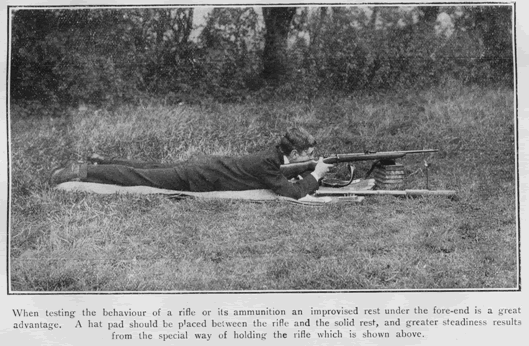
Trigger Mechanism.— The trigger mechanism consists of three
main parts, and it combines with its ordinary function that of supplying
a stop to hold the bolt in the rifle. The three main parts in question are
:
K The trigger.
L The trigger lever.
M The trigger spring.
The trigger, being of the double-pull type, means are provided for applying
two successive values of leverage during the operation of releasing the
firing pin. The trigger lever is pivoted at N, and it carries two projections,
0 and P. The projection 0 engages in a groove cut in the bolt, and acts
as the bolt stop. The projection P engages with a forward extension of the
firing pin nut E, and thus becomes the sear or retaining catch which holds
the firing pin in the cocked position. The trigger lever L must thus be
depressed to release the firing pin, and so discharge the cartridge. This
depression is effected by the trigger K, which acts as a lever having its
centre of motion on the pivot pin Q, with R and S for bearing surfaces.
The first part of the trigger pull acts with the leverage exerted with reference
to the bearing surface R. The powerful leverage it provides makes for a
long movement against a small resistance, and this constitutes the first
stage of the trigger release. The sear P is drawn down most of the distance
necessary to free the firing pin, but not far enough to effect its total
release. When the sear P has been drawn down so far that a little extra
movement will release the firing pin, the second trigger projection S comes
into action. The further movement of the trigger can then only be accomplished
under different conditions of leverage involving a short travel against
an increased resistance. It is by this means that the trigger is given a
long movement in the action of firing whilst still retaining for the shooter
the advantage of pausing before the final release, thus giving him time
to steady the aim at the critical moment when the tension on the trigger
finger is slowly rising to the strength necessary to produce discharge.
Operation of the Bolt.—The working of the bolt is substantially
the same as that of the ordinary service rifle. It unlocks with a quarter-turn
and has a reciprocating motion. When closing the bolt on a freshly-inserted
cartridge, the firing pin nut is caught on the sear P, so that whilst the
bolt continues to move forward, the firing pin is held back in the cocked
position.
This at once calls attention to the need for pulling on the trigger whilst
closing the bolt on an empty rifle. In that way the parts never take up
the cocked position, and the shooter is not tempted to snap the rifle on
an empty chamber, a proceeding which is particularly objectionable in rim-fire
rifles.
When using the rifle special care should always be taken to ensure properly
closing the bolt. This should be effected by firm pressure in preference
to anything savouring of a bang. If the bolt is not properly closed the
little projection U, shown in the separate detached view of the bolt, does
not come opposite the correspondingly shaped recess in the firing pin nut.
The rifle is then liable to misfire. This must be regarded as a necessary
inconvenience in all rifles, since it would be dangerous to permit discharge
to take place when the breech is not properly closed.
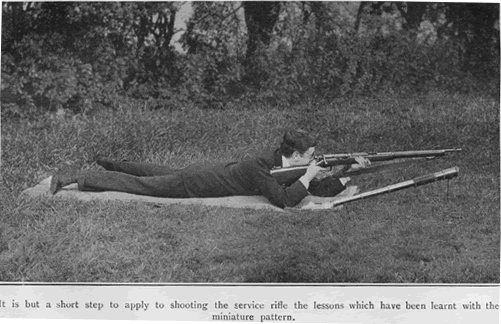 The
Safety Bolt.—A safety catch is considered advisable in a rifle
adapted to fire the • 22 L.R. rim-fire cartridge. As a rule the bullets
are so loosely held into the cases that, when once a rifle has been loaded,
the unfired cartridge cannot be extracted whole. The bullet remains jammed
in the entry to the rifling, and the case comes away, possibly spilling
the powder into the breech. At the word of command,
The
Safety Bolt.—A safety catch is considered advisable in a rifle
adapted to fire the • 22 L.R. rim-fire cartridge. As a rule the bullets
are so loosely held into the cases that, when once a rifle has been loaded,
the unfired cartridge cannot be extracted whole. The bullet remains jammed
in the entry to the rifling, and the case comes away, possibly spilling
the powder into the breech. At the word of command,
‘‘ Cease fire," or whenever it is desired to put a loaded
rifle at " safe," the safety bolt F should be turned over from
its normal position on the left to the opposite side. Under no conditions
should a rifle be allowed to remain for long, loaded and locked in the "
safe " position. It should either be discharged into the butt, or the
case should be extracted, the bullet being knocked out with a rod should
it remain behind.
Manufacture of the W.O. Miniature Rifle.—This rifle is patented
as regards the mechanism and registered in the matter of design, all rights
being the exclusive property of the War Office. A licence to manufacture
has been granted to the Birmingham Small Arms Co., Ltd., and the entire
resources of their up-to-date plant have been devoted to ensuring in each
rifle sold the same high grade of workmanship which is an acknowledged feature
of service rifles of B.S.A. make. By means of a large preliminary expenditure
on gauges, tools, and special machinery, each rifle can be turned out on
what is known as the interchangeable basis. This gives the user the benefit
of a greatly reduced cost of construction, combined with the knowledge that
any and all parts of the rifle can be replaced at short notice. Moreover,
when arms are made interchangeable, each individual weapon possesses those
merits of sweet working and fine adjustment which can only be produced in
a hand-made arm at a very high cost. It is a mistake to suppose that the
individuality of the manufacturer disappears when rifles are constructed
to government specification. This is not so. Every part, every detail, and
every adjustment reflects the precise degree
of care which is exercised in keeping the tools in first-class condition,
and it is upon the precautions taken in this connection that the accuracy
and wearing properties of a rifle depend. In the materials used there are
also many opportunities for enhancing quality in directions where experience
alone tells. To select just the right specification of metal and to impart
to it the exact degree of temper which will best enable each part to perform
its proper function is a study in itself, and it is on the strength of the
reputation the B.S.A. Company has gained in its many departments of manufacture
that the present reader is confidently advised to ask that any W. 0. miniature
rifle supplied to him shall bear the well-known stamp denoting the piled
arms and the initial letters " B.S.A."

General Statistics of the Rifle.
Weight of rifle ... ...
... ... ... ... ... ... ... ... ... ...5¼lb.
Length over all ... ... ... ... ... ... ... ... ... ... ... . 41¼ins.
Length of barrel ... ... ... ... ... ... ... ... ... ... ... 24 ins.
Length of stock (trigger to centre of butt)
... ... . 13½ ins.
Trigger pull: First stage of movement
between 1 & 21bs.
Final release ... ... minimum ... ... ... ... ... ... ... 41bs.
Distance between sights ... ... ... ... ... ... ... ... ... 18ins.
Distance from butt to back-sight... ... ... ... ... ... . 22¾
Sights.—The only portion of the sights which is not self-explanatory
to anyone viewing the illustrations is the device for lateral adjustment
of the rear notch. Such an adjusting device is usually termed a " wind-gauge,"
but it does not gauge the wind. The adjustment is mainly useful in miniature
rifles for getting the sights to lie so truly with the shooting of the barrel
that aim may be taken exactly underneath the bull. Skilled manufacture and
exhaustive testing are alike incapable of achieving an adjustment which
will be right for all shooters and all makes of ammunition. The manner of
holding the rifle, the tension on the sling, and the conditions of light
prevailing at the moment, are some of the causes which make a rifle, however
carefully adjusted in the first place, fail to throw the shots in accordance
with the aim taken. Many shooters give the rifle an infinitesimal jerk at
the moment of firing, which counteracts the apparent correctness of the
aim taken. In many instances the disturbance so caused is of such a uniform
character as to justify its correction on the sights. Other shooters, again,
have a slight degree of astigmatism in the eye, which results in throwing
the image of the foresight to one side or the other. This again is in the
nature of a constant error which necessitates the adjustment of the sights
to suit the individual.
When correcting the lateral adjustment of the sights it is well to bear
in mind the rule that the backsight
must be moved in the direction in which it is desired to alter the aim.
Shots going to the right require the backsight to be screwed to the left,
and vice versa. Since the cadet rifle foresight is made adjustable by fitting
it in a dovetail slot, it may be interesting to mention that the opposite
rule applies, viz., that the foresight must be moved in the direction of
the error. Reverting to the backsight, the rule may be put in another way.
The sight is raised to make the shots go higher, because in so doing the
butt is depressed. Likewise the backsight must be moved right or left respectively,
as the case may be, according to the side towards which it is intended to
direct the shots.
The use of a screw to control the lateral adjustment of the backsight enables
the shooter to make fine corrections on the micrometer principle. That is
to say, the screw thread has fifty turns to the inch, which means that one
complete turn makes a lateral movement equal to the fiftieth part of an
inch. A half turn thus produces a hundredth of an inch of side movement,
and so forth. To translate these movements into correction on the target
is a very simple matter. The rifleman's unit of angle is one minute, written
1', viz., one inch per 100 yards, or half-an-inch at 50 yards, or a quarter
of an inch at 25 yards. The minute of angle is frequently called a "
point," a useful term which avoids using the word " degree,"
a degree of angle meaning sixty minutes. 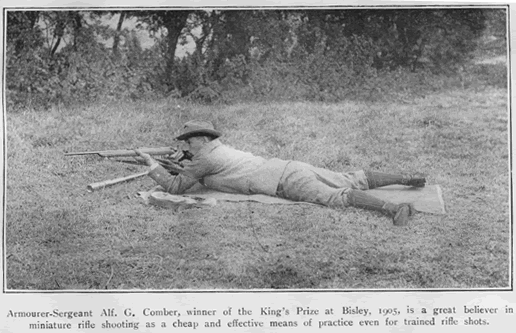 To
correct the shooting one minute of angle the backsight must be moved one
quarter of the revolution of the screw. The rule thus becomes :
To
correct the shooting one minute of angle the backsight must be moved one
quarter of the revolution of the screw. The rule thus becomes :
A quarter turn on the backsight represents
a quarter-inch correction at 25 yards, half-an-inch correction at 50 yards,
and one inch at 100 yards.
The above simple relation arises from the circumstance that the distance
between the sights is 18 inches or half a yard. Every correction made on
the sights is multiplied fifty times over on the 25 yards target, and in
proportion for other distances. Therefore, if a whole turn of the screw
produces the fiftieth of an inch movement on the backsight, the position
of the shot at 25 yards is altered fifty times this amount. No mathematical
training is necessary to grasp at once that fifty times the fiftieth part
of an inch equals one inch. This is no coincidence, the War Office deliberately
chose a screw with fifty turns to the inch and an 18-inch sight radius to
minimise the difficulties of training the young marksman to appreciate angle
in its relation to rifle shooting.
CHAPTER IV.
THE FLIGHT OF THE BULLET.
THE conditions which influence the trajectory
of a rifle bullet are seldom as well understood by the shooter as they might
be, partly because most textbooks on the subject deal too abstrusely with
the theory, and at the same time give too little of the kind of information
which is really useful on the range. An effort will here be made to steer
the right midway course between the two extremes.
Trajectory is defined as the curve described by the bullet in its flight
through the air. Its measurements are given with reference either to the
line of sight or to a line drawn in prolongation of the axis of the bore.
On the opposite page a curve of trajectory is shown for the •22 long
rifle cartridge which assumes that the barrel is fired horizontally. It
is calculated by mathematical formulæ and tables from the following
data :-
Diameter of bore, •22in.
Muzzle velocity of bullet, 1,100 feet per second.
Weight of bullet, 40 grains.
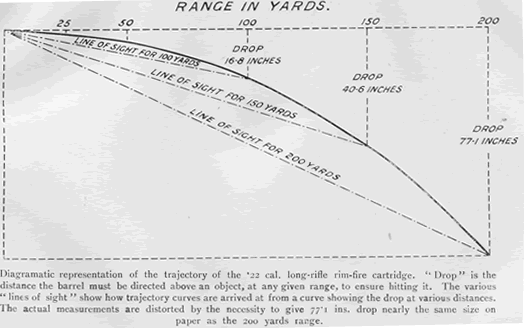 Coefficient
for shape of bullet nose equals unity. Given these particulars with reference
to any bullet, its flight can be estimated over the whole distance of its
travel with greater conformity to average results than could be obtained
by experimental shooting. Having once defined the conditions which exist
for horizontal firing, the position of the bullet with reference to the
line of sight can be obtained for every range adjustment. It is only necessary
to assume lines of sight drawn to intersect the trajectory at the various
shooting distances for which values are required. The diagram already mentioned
shows what is meant. In practice these measurements cannot be made on paper,
since the results are falsified because the drawing must contain two sets
of scale reductions, the one to show, say, 200 yards range on a matter of
20 inches width of paper, whilst the drop of the bullet is shown very much
nearer to actual size. Calculation is thus again necessary to deduce from
a table of " drops " the curve of trajectory for various sight
adjustments. The values so obtained must be subjected to a further series
of corrections to take account of the disturbing effect arising from the
height of the foresight above the muzzle orifice. These operations having
been duly carried out, a trajectory table can be set down which shows the
exact course which the bullet will follow under any reasonable series of
sighting conditions. The Field has worked out a very complete set
of tables for the various kinds of •22 calibre cartridges, probably
the only tables of the kind in existence. A novel system has been adopted
for setting out the results, viz., to indicate the line of sight by means
of a ruled line on the page, and to show the positions of the bullet at
the various ranges, above or below that line as the case may be. Permission
having been granted to make use of the tables in question, they are introduced
at the end of this chapter.
Coefficient
for shape of bullet nose equals unity. Given these particulars with reference
to any bullet, its flight can be estimated over the whole distance of its
travel with greater conformity to average results than could be obtained
by experimental shooting. Having once defined the conditions which exist
for horizontal firing, the position of the bullet with reference to the
line of sight can be obtained for every range adjustment. It is only necessary
to assume lines of sight drawn to intersect the trajectory at the various
shooting distances for which values are required. The diagram already mentioned
shows what is meant. In practice these measurements cannot be made on paper,
since the results are falsified because the drawing must contain two sets
of scale reductions, the one to show, say, 200 yards range on a matter of
20 inches width of paper, whilst the drop of the bullet is shown very much
nearer to actual size. Calculation is thus again necessary to deduce from
a table of " drops " the curve of trajectory for various sight
adjustments. The values so obtained must be subjected to a further series
of corrections to take account of the disturbing effect arising from the
height of the foresight above the muzzle orifice. These operations having
been duly carried out, a trajectory table can be set down which shows the
exact course which the bullet will follow under any reasonable series of
sighting conditions. The Field has worked out a very complete set
of tables for the various kinds of •22 calibre cartridges, probably
the only tables of the kind in existence. A novel system has been adopted
for setting out the results, viz., to indicate the line of sight by means
of a ruled line on the page, and to show the positions of the bullet at
the various ranges, above or below that line as the case may be. Permission
having been granted to make use of the tables in question, they are introduced
at the end of this chapter.
The bullet in every instance commences its flight 0•8 of an inch below
the tip of the foresight. It rapidly rises till it cuts the line of sight,
and following that goes higher still till it reaches its culminating point.
Thereafter it commences to fall till it again intersects the line of sight,
this being the distance for which the sights are set. Turning more particularly
to Table I., which denotes the trajectory for the cartridge already mentioned,
it will be seen that when the sights are set for 50 yards range, the bullet
is only 0•6 of an inch high at the half-way distance. The shooter
would naturally assume that the bullet would drop more than this amount
in passing over 25 yards of its course. In point of fact it drops nearly
4 inches, but the peculiar influence which is exerted by the height of the
foresight reduces to little more than half-an-inch the correction which
the shooter must allow. For this reason it is hardly necessary to make any
distinction in the marking of elevation on -22 calibre rifles as between
25 and 5o yards, when such small values as half-an-inch are in question.
The varying diameter of the bull's eye at different distances, and the conditions
of light existing for the time being, cause variations which are of equal
importance. The function of the range markings on a rifle sight is thus
mainly to enable the shooter to get the shots on the target. When once he
knows where the shots are going, he can adjust his sights a little at a
time till the right elevation is obtained. The ammunition itself is not
so exactly standardised as to make it possible to take the sight markings
too literally.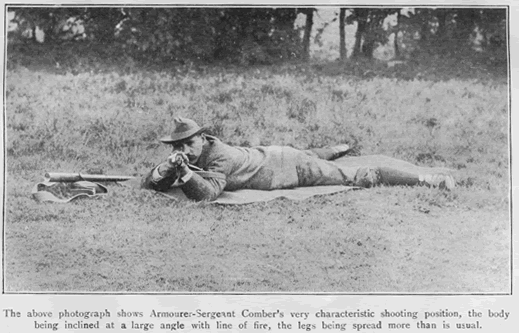
A private mark may certainly be made on the sight to denote the position
of a favourable adjustment when once found ; but it does not follow that
the same mark will be true for another day. This is where the value of a
sighting shot comes in. If it is taken with the same amount of care which
is accorded to the shots counting in the score, a shooter, who knows his
rifle and how to manipulate his sights, can make such an adjustment as will
correct any error which the trial shot may disclose.
A whole chapter could be devoted to emphasising the various points made
clear by the trajectory tables which appear further on. It is, however,
unnecessary to labour the demonstration of something which tells its own
tale. The shooter will know much more about trajectory if he tests the table
values by the behaviour of his own rifle. Let him adjust his sights for
100 yards shooting, and then fire at 50 and 25 yards. Careful measurements
of the divergences found will show to what extent practice and theory are
in agreement. If the results are much out, theory is not proved wrong. It
merely implies that the rifle and cartridge are not giving standard results.
However, it may be interesting to state that ordinary variations in cartridges
and rifles produce no greater differences than result from the shooter's
own inability to say which shot out of a series truly represents a fair
average centre for the whole of the group. Except with the most skilful
shooters the grouping is seldom close enough to define with more than approximate
accuracy where the average shooting lies.
The question of the dispersion of shots here opened up is a very large one.
The beginner must entirely free his mind from the belief that the merit
in a score at short distances is only to be measured by the number of bulls
made. Close grouping of the shots is a far more important condition to strive
for in the early stages. Given a good rifle and good cartridges, experiments
tell us that if the weapon is rigidly held in a vice or other solid rest
ten successive shots at 25 yards should make a hole which can in most cases
be covered by a sixpence. The beginner more often needs sixpennyworth of
coppers to cover the diversity of his grouping.
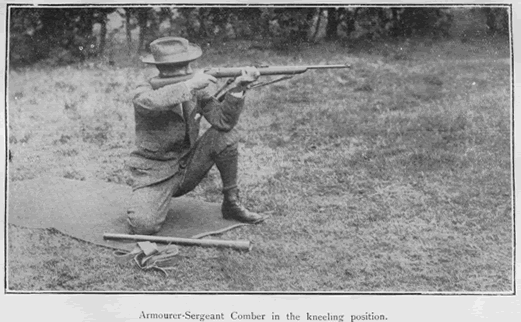 It
seems absurd to suppose that anyone could fail to point a walking-stick
correctly at a dinner-plate 25 yards away ; and yet, with all the aids of
stock, sling, and delicate sights, beginners have been known to miss a 6-inch
square target at 25 yards. The first encouraging sign is, therefore, when
the shooter can keep all the individual shots of a series in a space 3 inches
square. If six out of seven are in a square inch, and one shot is a wild
one, then the sudden panic which caused the rifle to jerk at the critical
moment must be watched for and avoided. When there is evidence of capacity
to keep the shots in something like consistent groups, it is time enough
to alter the adjustment of the sights so as to bring the group into the
region of the bull.
It
seems absurd to suppose that anyone could fail to point a walking-stick
correctly at a dinner-plate 25 yards away ; and yet, with all the aids of
stock, sling, and delicate sights, beginners have been known to miss a 6-inch
square target at 25 yards. The first encouraging sign is, therefore, when
the shooter can keep all the individual shots of a series in a space 3 inches
square. If six out of seven are in a square inch, and one shot is a wild
one, then the sudden panic which caused the rifle to jerk at the critical
moment must be watched for and avoided. When there is evidence of capacity
to keep the shots in something like consistent groups, it is time enough
to alter the adjustment of the sights so as to bring the group into the
region of the bull.
To assume that every shot has been correctly fired, and to endeavour to
adjust for every divergence, before there is evidence of consistency from
shot to shot, is to engage in a hopeless struggle. It is not marksmanship
to spend one's time chasing one's own errors round the target. Many think
it is, and the delusion arises from the tendency to seek scientific explanations
for every bad shot. When the shooter observes a consistent tendency to go
high or low, or right or left, better, even then, than to readjust the sight,
is to watch each shot fired ; concentrating attention on seeing that the
aim does not stray unconsciously in the direction towards which a bias is
shown. Experienced shooters will be able to confirm the soundness of this
advice from the many occasions when they have found that, after making an
apparently necessary correction, the results show that it was not, after
all, the rifle which was in error, but the man behind it. If a persistent
bias is observed on carefully examining a target showing the result of a
carefully aimed series of shots, a slight re-adjustment should be made,
preferably not to the extent of the whole of the error, but say half of
it.
The study of the flight of the bullet thus naturally divides itself into
a consideration of trajectory with reference to the action of gravity, and
the various eccentricities of flight which may be included in the term dispersion.
The shooter must endeavour to cultivate the power of knowing whether a false
result arises from his own error or something in the rifle or ammunition.
The idea that only bad workmen complain of their tools is certainly inapplicable
to rifle shooting. The better the shot the more critical he becomes, and
long experience alone shows how serious are the errors which may arise from
no fault of the shooter. The inaccuracy may be due to his own or someone
else's neglect, not necessarily on the range, but perhaps at home when duty
cries out for the rifle to be cleaned, and inclination suggests that dinner
should come first. The shooting of the rifle deteriorates, because neglect
once sanctioned may continue on and on through a period sufficient for the
eating of many dinners.
CHAPTER V.
GENERAL HINTS ON SHOOTING AND THE CARE OF THE RIFLE.
Position.—The adoption of
a steady and comfortable position may best be achieved under the tuition
of an experienced shot. General ideas for personal guidance may be gained
from the varied series of illustrations which appear amongst these pages.
The body should lie at an angle with the line of the rifle, and the elbows
should be brought closer together than the natural tendency suggests. The
cheek should lie on the stock, so as to preserve unaltered the alignment
between eye and sights when once it has been gained. Attention may then
be more particularly concentrated on the view presented by the foresight
and bull. Although the recoil is slight with the new miniature rifle, it
is desirable to cultivate from the start the power of bedding the butt firmly
against the shoulder.
 Pressing
the Trigger.—When the body is comfortably placed, and the breathing
has settled down to a regular action, the first general adjustment of the
line of aim may be effected. When the face is correctly situated so as to
bring the eye into alignment with the sights, and when there is general
evidence that the time has come for firing the shot, the breathing should
be checked and the trigger should be drawn back till the commencement of
the second stage of pull has been reached. The entire art of successful
shooting then consists in stilling as far as possible the natural tremour
of the rifle. When the mind is satisfied that the rifle has at last attained
its maximum degree of steadiness, and the foresight is correctly viewed
beneath the bull, the finger pressure may be gradually increased, so gradually
in fact that the precise moment of release cannot be estimated. Some little
strength of mind is necessary to retain such control of the faculties that
the eye continues to view the fore -sight after the shot has been fired.
At all events avoid the hasty removal of the rifle from the shoulder, in
fact endeavour to get a last look at the sights after discharge. If it is
found that want of breath causes distress at the actual moment of shooting
it is better to start again from the beginning, endeavouring the second
time to achieve steadiness of aim before the sensation of suffocation comes
along.
Pressing
the Trigger.—When the body is comfortably placed, and the breathing
has settled down to a regular action, the first general adjustment of the
line of aim may be effected. When the face is correctly situated so as to
bring the eye into alignment with the sights, and when there is general
evidence that the time has come for firing the shot, the breathing should
be checked and the trigger should be drawn back till the commencement of
the second stage of pull has been reached. The entire art of successful
shooting then consists in stilling as far as possible the natural tremour
of the rifle. When the mind is satisfied that the rifle has at last attained
its maximum degree of steadiness, and the foresight is correctly viewed
beneath the bull, the finger pressure may be gradually increased, so gradually
in fact that the precise moment of release cannot be estimated. Some little
strength of mind is necessary to retain such control of the faculties that
the eye continues to view the fore -sight after the shot has been fired.
At all events avoid the hasty removal of the rifle from the shoulder, in
fact endeavour to get a last look at the sights after discharge. If it is
found that want of breath causes distress at the actual moment of shooting
it is better to start again from the beginning, endeavouring the second
time to achieve steadiness of aim before the sensation of suffocation comes
along.
Control of the Eyes.—In regard to the focus of the 'eyesight
the shooter develops an exceptional amount of control in this regard which
he exercises unconsciously. For the beginner to achieve early success an
endeavour should be made to observe simultaneously two objects at different
distances from the eye. The back sight and foresight should first be viewed
so as to ensure placing them in correct line both vertically and horizontally
with the eye. The attention should next be directed towards laying the foresight
centrally beneath the bu!l. This is accomplished by causing the eye to observe
a combined image of the foresight and the bull. Neither is seen with the
absolute sharpness which focussing on one object alone will ensure, but
a kind of middle adjustment is obtained which can best be expressed by the
advice to view the two objects simultaneously. In these circumstances it
is desirable to close the left eye whilst shooting. As the sights are invisible
to the left eye, whilst the target is in full view, the opening of the left
eye tends to carry the focus of both eyes to the target, the result being
that the sights are not seen so clearly as is desirable. For rapid shooting
and for shooting in bad light both eyes may be open.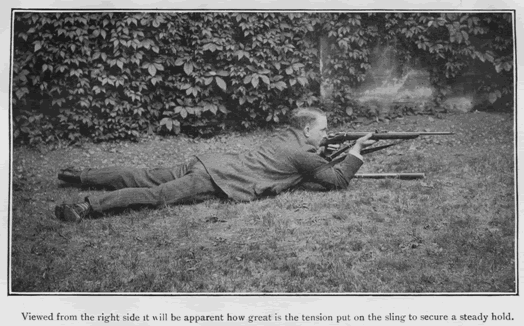
Orthoptics.--The principle of the orthoptic aperture is that the
peephole diminishes the active area of the pupil of the eye. This gives
extra depth of focus. in exactly the same way that a small stop in a camera
increases the power of defining all portions of a landscape. The scientific
explanation need not be advanced here. It is sufficient to say that every
shooter should take an early opportunity of borrowing a pair of these spectacles,
and patiently practising their use. It will at once be apparent that for
young eyes and old eyes alike, and especially for those who are slightly
astigmatic, to view the sights through a small aperture is to diminish the
amount of blurr. The smaller the hole used, the less the blurr ; but a point
is soon reached when the loss of light, which accompanies an unduly small
size of aperture, creates difficulties which overpower the extra advantage
gained.
There is a medium in all things, and the medium size of aperture is the
one which imparts sharpness to the sights without cutting off too much light.
It goes without saying that the size of hole should be adjusted by trial
to suit the illumination on the target.
Sling.—The advantage of a sling on the rifle is that steadier
hoiding is possible when the muscles are well employed. Just as it is easier
to hold the outstretched hand steadier when grasping a fairly weighty object
than when the Muscles are unloaded, so the rifle can be held with less tremble
when the pull of the sling gives the muscles something to do. In a similar
fashion the sling pulls the rifle into the shoulder, so leaving the right
hand comparatively free to manipulate the trigger. The efficiency of the
sling very much depends on adjusting it to the figure, so as to make it
tight enough to be of real assistance to the shooter. When tight enough,
the left hand requires to be fairly wedged into its position for gripping
the fore-end. The illustration facing page 2 shows the method of winding
the arm into the sling.
Blacking the Sights.—It is always desirable to colour the
sights a dead black previous to shooting, in order to deaden any glints
which may interfere with their clear definition. The smoke of a wax match
produces a nice surface, but the inability to use it except under cover
makes the bottles of lamp-black solution preferable for range use.
To Test a Rifle.—Musketry instructors are apt to discourage
the use of a muzzle-rest under any circumstances, but when the shooter really
desires to test the behaviour of his rifle, ammunition, or the adjustment
of the sights, such a device is not only-excusable but positively beneficial.
More information can be gained from ten shots so fired than from fifty with
the rifle unsupported. The illustration facing page i6 shows an excellent
method of supporting the rifle for such a test. Instead of holding the rifle
in the usual manner, the toe of the stock may be grasped, in the left hand,
the closed fist resting directly on, the ground. The rifle is then held
almost entirely free of body tremors. The ordinary position, using the rest
merely as an added support, is not quite so, steady. Although not generally
admitted to be true, there can be little doubt that a course of shooting
with the help of a rest forms an excellent education for the shooter. It
instructs the eye what steady holding really means, and it enables gentle
trigger pressure to be cultivated in its highest form. Moreover, when a
shooter finds himself making persistently bad scores, the improved results
commonly experienced when a rest is used suggest that past errors have arisen
from unconsciously jerking the rifle at the-moment of firing. Particular
care must always be taken when using a rest that the support is placed.
well back under the fore-end, since the slightest bending of the barrel
at the muzzle will deflect the shots and falsify the sighting.
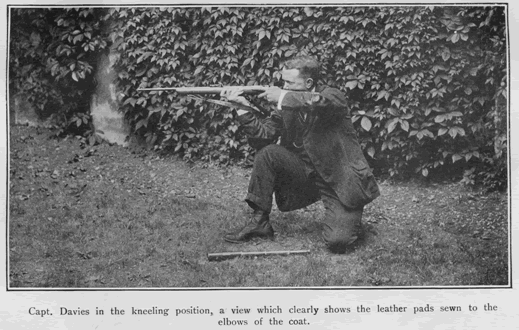 Clothing.—The
shooter should always endeavour to use old and roomy clothes for range practice.
If the elbows get chafed by the friction arising from an unaccustomed attitude
the trouble may be ameliorated by the use of leather pads sewn on to the
sleeves. These have the further advantage of saving wear on the clothes.
Though Norfolk jackets form the approved shooting costume, few of them are
made so that the back pleat really expands under tension. The more expensive
shooting coats are made with the back pleat really elastic, the two sides
being eyeletted and strung together with fine elastic, so as to give under
use, whilst returning to the conventional shape at ordinary times. A stiff
collar is a great trouble to the shooter with a modest length of neck. The
linen collar should either be entirely removed, or, better still, be replaced
with one of the modern athletic flannel collars. A soft hat with a wide
brim is a great advantage in shooting, not only because it holds better
to the head but because it diminishes the top light falling on the eye.
Clothing.—The
shooter should always endeavour to use old and roomy clothes for range practice.
If the elbows get chafed by the friction arising from an unaccustomed attitude
the trouble may be ameliorated by the use of leather pads sewn on to the
sleeves. These have the further advantage of saving wear on the clothes.
Though Norfolk jackets form the approved shooting costume, few of them are
made so that the back pleat really expands under tension. The more expensive
shooting coats are made with the back pleat really elastic, the two sides
being eyeletted and strung together with fine elastic, so as to give under
use, whilst returning to the conventional shape at ordinary times. A stiff
collar is a great trouble to the shooter with a modest length of neck. The
linen collar should either be entirely removed, or, better still, be replaced
with one of the modern athletic flannel collars. A soft hat with a wide
brim is a great advantage in shooting, not only because it holds better
to the head but because it diminishes the top light falling on the eye.
Ammunition.—Users of the • 22 rifle must beware of
making constant changes in the brand of cartridge. The W. 0. miniature rifle
being chambered for the "long rifle" length of cartridge, those
known as the " long" and the " short " will necessarily
give inferior results. Above all things is it desirable that " short"
cartridges charged with smokeless powder should be used with discrimination.
Too many of these give excessive pressure, whose existence is demonstrated
by undue deformation of the case. At times slight bursts and breaks occur,
which are evidenced by escape of gas at the breech. A brand of cartridge
giving good results when the rifle is shot from a rest may be used with
the confidence which comes with knowing that the ammunition behaves well
with skilful holding. A proportion of wild shots must occur when the short
cartridge is fired in the full length chamber. Hence this ammunition should
only be used in the W. O. M. rifle when noise, smoke, or other considerations
exclude the full-size cartridge.
Safety.—The shooter must never forget that •22 calibre
cartridges have been known to break windows and do other damage at distances
as remote as 500 yards from the firing point. It is, therefore, criminal
to fire a shot without knowing precisely where it will strike.
Mis-fires.—Great as is the care taken by the manufacturers
to get the detonating composition evenly distributed around the rim of the
cartridge, instances must arise when it is lacking at the particular spot
struck by the firing pin. The first thing to do following a miss-fire is
to pull back the firing pin nut, and so re-cock the rifle. At the second
attempt it may go off. If it still fails, supposing the bullet to remain
stuck in the barrel, the case shoud be extracted, being then reinserted
after giving it a half-turn. Such shots are best not fired at the target,
for fear some powder may have been spilt into the action. If the cartridge
again fails to go off, the case should be withdrawn, the bullet being then
knocked out with a rod inserted from the muzzle.
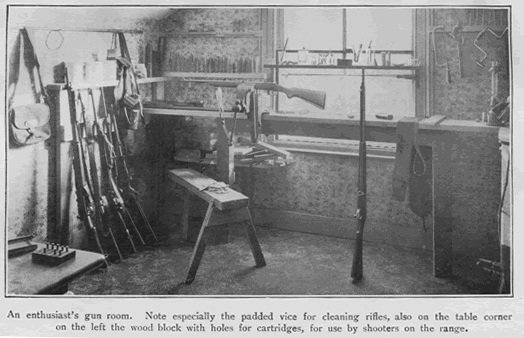 Cleaning
the Rifle.—There is only one safe rule in cleaning
rifles, viz., to be prompt and thorough. The slightest speck of rust, when
once allowed to form, makes a cavity, or roughness of the surface, which
ultimately extends and ruins the barrel. The great justification for taking
extreme care of a rifle is that, so long as the mirror-like surface can
be retained, cleaning is easily performed. There is also the great satisfaction
of seeing a good result for the labour expended. The rag attached to a "
pull-through " cord is not a sufficiently thorough method of cleaning.
One of the best kinds of rod to use is one having a head like the eye of
a needle. Pieces of thin rag or flannel can be torn to the right width of
strip. and a sufficient length can be inserted in the loop on the rod. Two
successive wipings with a well-fitting dry " patch " will remove
the worst of the fouling which remains after using black powder. A brush
dipped in stiff grease, such as vaseline, may then be applied. Thin oil
is objectionable because it is apt to run off the surface and leave parts
of the bore uncovered. A rifle is best left for awhile after it has received
this amount of attention. A few hours or even a couple of days later the
above treatment should be repeated, any foreign matter remaining in the
bore being by then sufficiently softened to come away. Some people recommend
pouring hot water or hot soda water down the barrel. This may be right for
military rifles firing cordite, but is messy and quite unnecessary for weapons
firing black or smokeless powder in combination with lead bullets. The condition
of a rifle is best preserved by prompt and simple treatment immediately
after shooting, as compared with more radical measures applied some time
after the rifle has been shot. When smokeless powder cartridges are used
the dry state of the barrel must be corrected by an application of thin
oil before the dry rag is used. When the bore has been well cleaned the
preservative dressing of thick grease should be applied. A rifle never really
looks nice if the bore alone is cleaned. The exterior surface of the metal
should be freed from the rusting effects of the moisture deposited by the
hands. No better treatment can be given than to dip a hard paint brush kept
for the purpose into stiff grease, and paint the metal work therewith. This
ensures getting the grease where an oily rag would not penetrate. The grease
painted on with the brush may be spread, and the surplus. removed, by brisk
rubbing with a rag. The only perfect method of cleaning a rifle is to grasp
it in a well-padded vice, in the manner illustrated facing page
40. Every range should be fitted with a bench and vice on this plan,
with an outfit of rods, brushes, and grease for the use of the members.
Cleaning
the Rifle.—There is only one safe rule in cleaning
rifles, viz., to be prompt and thorough. The slightest speck of rust, when
once allowed to form, makes a cavity, or roughness of the surface, which
ultimately extends and ruins the barrel. The great justification for taking
extreme care of a rifle is that, so long as the mirror-like surface can
be retained, cleaning is easily performed. There is also the great satisfaction
of seeing a good result for the labour expended. The rag attached to a "
pull-through " cord is not a sufficiently thorough method of cleaning.
One of the best kinds of rod to use is one having a head like the eye of
a needle. Pieces of thin rag or flannel can be torn to the right width of
strip. and a sufficient length can be inserted in the loop on the rod. Two
successive wipings with a well-fitting dry " patch " will remove
the worst of the fouling which remains after using black powder. A brush
dipped in stiff grease, such as vaseline, may then be applied. Thin oil
is objectionable because it is apt to run off the surface and leave parts
of the bore uncovered. A rifle is best left for awhile after it has received
this amount of attention. A few hours or even a couple of days later the
above treatment should be repeated, any foreign matter remaining in the
bore being by then sufficiently softened to come away. Some people recommend
pouring hot water or hot soda water down the barrel. This may be right for
military rifles firing cordite, but is messy and quite unnecessary for weapons
firing black or smokeless powder in combination with lead bullets. The condition
of a rifle is best preserved by prompt and simple treatment immediately
after shooting, as compared with more radical measures applied some time
after the rifle has been shot. When smokeless powder cartridges are used
the dry state of the barrel must be corrected by an application of thin
oil before the dry rag is used. When the bore has been well cleaned the
preservative dressing of thick grease should be applied. A rifle never really
looks nice if the bore alone is cleaned. The exterior surface of the metal
should be freed from the rusting effects of the moisture deposited by the
hands. No better treatment can be given than to dip a hard paint brush kept
for the purpose into stiff grease, and paint the metal work therewith. This
ensures getting the grease where an oily rag would not penetrate. The grease
painted on with the brush may be spread, and the surplus. removed, by brisk
rubbing with a rag. The only perfect method of cleaning a rifle is to grasp
it in a well-padded vice, in the manner illustrated facing page
40. Every range should be fitted with a bench and vice on this plan,
with an outfit of rods, brushes, and grease for the use of the members.
Rifle Cover and Rack.—The shooter who really appreciates
his rifle will be unwise to go for long unprovided with a proper leather
case for transit. The rifle should never be left in the cover when at home.
The cover may contain unsuspected traces of damp, and the act of removing
the rifle from the cover is seldom unaccompanied by a general inspection
which may or may not bring to view unsuspected signs of neglect. If a proper
gun rack cannot be provided it can be suspended on hooks against the wall.
The horizontal position is better than the vertical, since it prevents the
grease in the barrel from gravitating to the bottom. It is wrong,. again,
to lean a rifle in the corner of a room. There is no knowing how often a
rifle so placed may be knocked over in the course of a week. Above all things
remember that the umbrella stand is not a proper place in which to keep
a rifle.
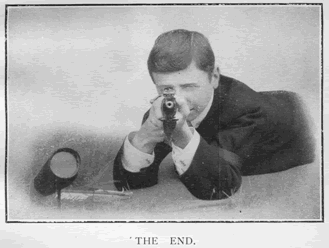
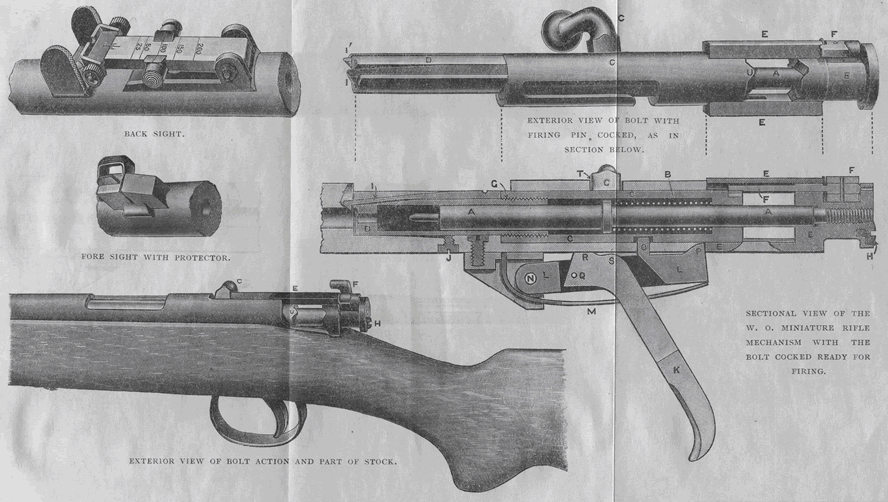
A FEW WORDS ABOUT THE 22 LEE-ENFIELD.
The logical necessity of miniature practice with the service arm naturally
embodies a rifle reproducing all the details cf the service weapon, with
the sole exception of a barrel specially bored to take the •22 cartridge
and a bolt adapted in the head to detonate a rim-fire case.
With such a combination the sights can be laid directly on to the bull,
and there is no need, as with tubes and adapters,. to mar the value of the
practice obtainable by aiming off the bull for the purpose of correcting
the almost inevitable divergence which must exist between the line of the
sights and the direction in which the shots are thrown.
The B.S.A. -22 Lee-Enfield rifle is confidently recommended for adoption
in all indoor and other ranges where it is desired that shooting shall be
practised under conditions as nearly "as possible reproducing full-range
practice with the service rifle.
A great advantage of the B.S.A. .22 Lee-Enfield is that this rifle can be
supplied chambered for the •22 " short " rim-fire cartridge
beside the " long 'rifle!" cartridge. First-class results can
thereby be obtained in indoor ranges, accompanied by the diminished noise
and smoke which the use of the small cartridge entails. The cost of erecting
a suitable stopping butt or bullet catcher is of course less when these
light cartridges are used. It is well known that the inexpensive short cartridge
does not give the best results when fired from a rifle chambered for the
full-length cartridge.
CONCERNING SERVICE PATTERN MATCH RIFLES.
Rifle shooting to be enjoyed in its highest aspects must
represent a direct strife between the shooter's skill on the one hand, and
the opposing influences of wind and weather on the other. Disturbing elements
which arise from faults in the rifle and ammunition delay progress until
they have been eliminated.
B.S.A. match rifles are not only of strictly service pattern, but receive
throughout the whole course of their manufacture and subsequent testing
special care and attention, the object being to give the shooter as perfect
a weapon as up-to-date methods can produce.
The user of a Government viewed B.S.A. match rifle accordingly occupies
the very favoured position of knowing that his rifle will collaborate in
full sympathy with the efforts made by the shooter to put on good scores.
A rack rifle may shoot just as well as a best match rifle ; but in range
firing so much depends on having confidence in the rifle used that it is
always wise to be on the safe side.
AIR-RIFLES.
No matter how extensive an armoury the enthusiastic shooter
may possess, he will probably obtain more regular enjoyment and more positive
pleasure from the casual use of his air-rifle than from all the other arms
put together. To the man who must live within easy reach of his daily work,
the air-rifle is the only weapon with which regular practice can be obtained
without going outside the limits of an ordinary suburban garden.
Great as were the mechanical problems to be overcome in designing and manufacturing
a satisfactory air-rifle, the problems in question have been absolutely
solved in the B.S.A. model. Its use is accordingly unhesitatingly recommended
to those who have in the past stood aloof from air-guns on account of their
reputation for frequently needing repair and their hitherto incurable lack
of accuracy.
and, if you have not yet visited that page, read a comprehensive write-up on the rifle
and the War Office Specification for the rifle
Return to: TOP of PAGE
See this website's Raison d'être